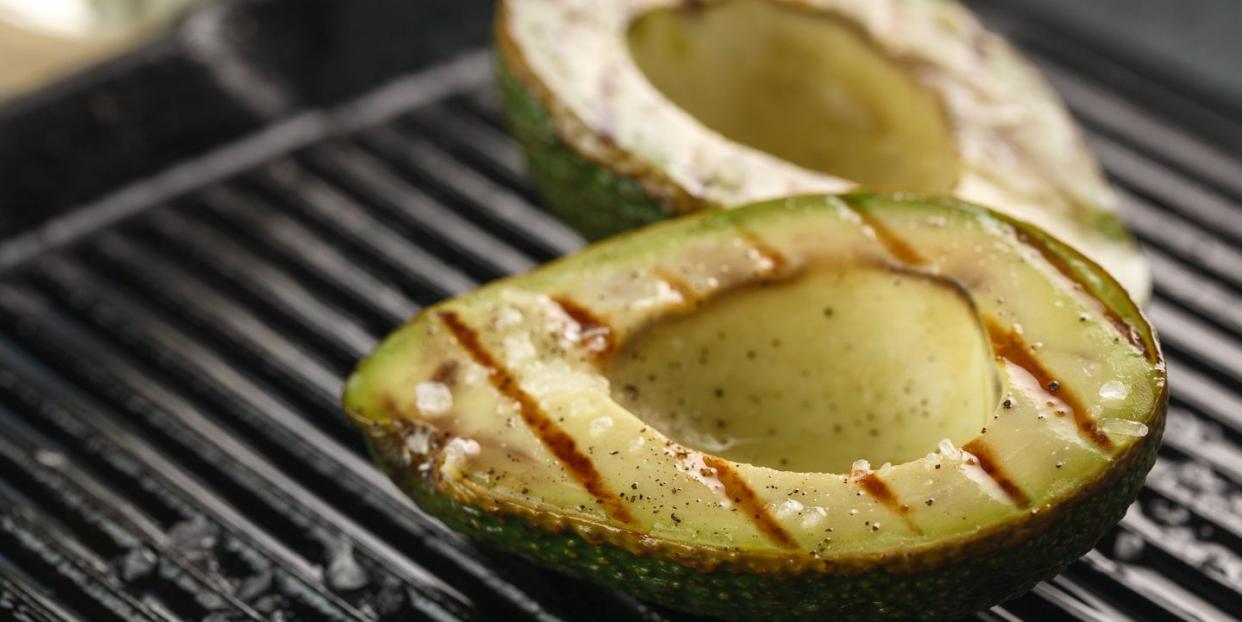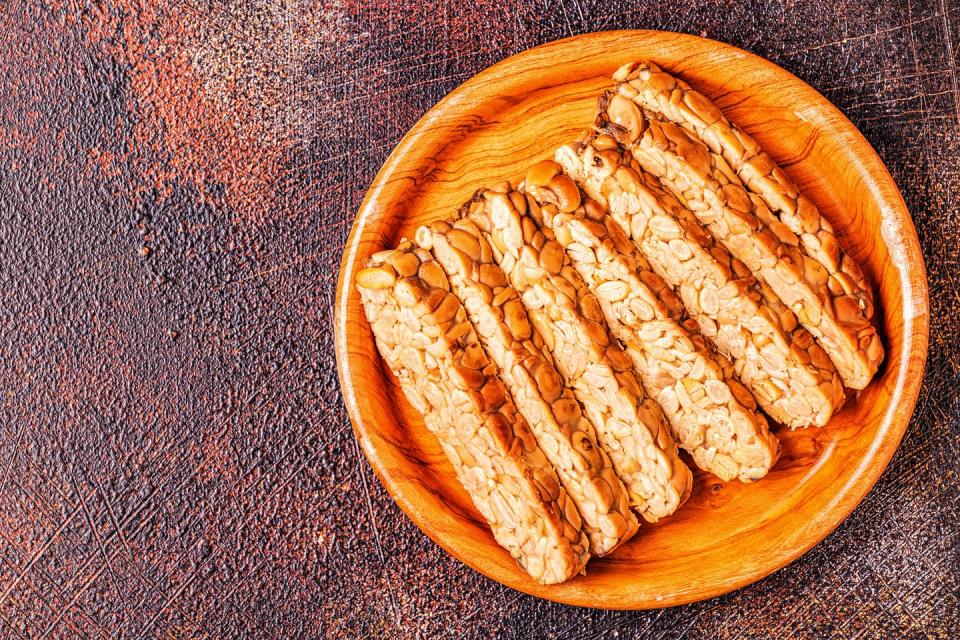If You're Not Throwing These 6 Foods on the Grill, You're Doing Summer Wrong

During the season of long days and long runs, there are few greater joys than firing up the grill to make a healthy meal. But if your grilling routine is as adventurous as melting a slice of cheddar on a beef patty, you’re selling this cooking method short.
There are plenty of other non-traditional foods out there that taste even better when flecked with a bit of char—many of which are also packed with the nutritional firepower needed to support your training.
Here are six foods that are ready to come out from hamburgers’ long shadow and rekindle your thrill of the grill. We guarantee you’ll flip over them.
[Runner’s World 10-Minute Cross-Training, gives you five muscle-building routines that take just 10 minutes to get you stronger.]
1. Tempeh

Think of tempeh as the veggie steak of the grill and healthier than those highly-processed meatless burgers. Made from whole soybeans which are soaked, cooked, fermented, and formed into a firm patty with a nutty-umami flavor, tempeh holds up very well on the grill and delivers plenty of nutritional perks.
Namely, every 4-ounce serving supplies 20 grams of plant protein (more than twice the amount in tofu) as well as healthy amounts of dietary fiber, and a range of essential nutrients including magnesium, phosphorus, and B vitamins. Research presented at the online meeting of the American College of Cardiology and World Congress of Cardiology found that men who consumed more plant-based foods had a 25-percent reduced risk of heart disease, and women had an 11-percent reduced risk, compared with those who ate more animal-based foods.
But these benefits only held true when people ate mostly nourishing plant foods like tempeh instead of processed plant foods such as refined grains. When you grill tempeh, you risk killing off its population of beneficial bacteria, however there might be benefits to fermentation that goes beyond probiotics—like creating new helpful acids and altering nutrients to make them more digestible.
How to grill: Season a block of tempeh with salt and pepper, or, better yet, bathe it for a few hours in your favorite marinade. Place on greased grill grates and cook, turning over once until darkened with some grill marks, about 8 minutes total. You can also cube and grill kebab-style.
2. Kale

If you’re unsure about kale, try it grilled before writing it off for good. The grilled leaves become crunchy and charred in some spots, while chewy and tender in others. A bastion of healthy eating, kale is saturated with an alphabet of vital nutrients including vitamin C, vitamin A, and vitamin K. A recent investigation out of Tufts University found maintaining adequate vitamin K levels is good idea if you want a better chance of living longer. Why? Vitamin K is important for several bodily functions, including maintaining healthy blood vessels.
How to grill: The best type of kale for the grill is Tuscan kale, also known as Lancinato or dinosaur kale, since the leaves can lie flat on the grill as opposed to curly kale (the edges can dip below the grill grates and burn). Brush leaves with oil, and season with salt and pepper. Lay the kale side by side in a single layer on top of the grill grate, and heat until crispy in spots, about 2 minutes. Turn over and grill on the other side until darkened in spots, 1 to 2 minutes. Serve drizzled with fresh lemon juice and some grated Parmesan cheese, or roughly chop and make the base of your salad.
3. Halloumi

This salty cheese hailing from Cyprus has a high melting point that makes it easy to grill since it won’t melt through the grill grates. Over the flames, the outside becomes crispy while the inside turns velvety. Traditionally made with a combo of sheep’s and goat milk, halloumi supplies both bone-friendly calcium and muscle-building protein (about 6 grams in each ounce serving, or nearly the same amount found in chicken breast). Since it’s on the salty side, consider the cheese a great food to toss on the grill after a sweaty workout to help replenish those electrolytes. You can find halloumi at most Middle Eastern grocers and at the cheese counter of some regular supermarkets.
How to grill: Upend a block of halloumi and slice lengthwise into two big slabs. Brush with oil, and heat until browned with grill marks appearing on both sides and cheese has softened, 1 to 2 minutes per side. You can serve it like you would steak or add slices to a summer salad. Halloumi also works great grilled as kabobs with sliced veggies or stuffed between a bun and served burger-style.
4. Avocado

Want the best guacamole ever? Then be sure to grill your avocado first. If it seems strange, just think about those flavor-boosting grill marks and the smoky taste that a grill provides with other more common grilled foods like sausages.
Including avocado in your backyard cooking may help keep hunger at bay. A study published in the Nutrition Journal found that people who ate half an avocado as part of a meal felt 26 percent more satisfied three hours later than those who didn’t. This outcome could be attributed to the fact that avocados are high in filling fiber and unsaturated fats.
How to grill: Simply slice an avocado in half and remove the pit. Brush the inside with oil and season it with salt and pepper. Place it flesh-side down on a hot grill grate for about 5 minutes, or until you get some nice grill marks. Scoop out flesh and mash into guacamole or use the mash as a burger topping, cube and add to salads, or slice and place in tacos or sandwiches.
5. Watermelon

Grill pros are wise to something that many novice barbecuers overlook: Sending fruit like watermelon to the flames encourages their natural sugars to caramelize, making them an even sweeter treat. On top of being one of the most hydrating summer fruits, watermelon is a good source of lycopene—an antioxidant that may help lower blood pressure numbers with higher intakes. Peaches, nectarines, and plums can also benefit from time on the grill grates.
How to grill: Slice watermelon into wedges and lightly coat both sides with oil. Grill over medium heat, turning once, until a few dark marks appear and the fruit becomes less water-logged, about 5 minutes total. Eat straight up, chop and add to salads or salsas, or for a healthy dessert, top grilled wedges with dollops of Greek yogurt and chopped nuts.
6. Mussels

Ultra sustainable and budget-friendly, mussels are a great grilling option. On the grill, mussel meat becomes slightly sweet with a hint of smokiness. On top of supplying plenty of protein to help your muscles recover from training, the shellfish mussels are a source of the same heart-healthy omega-3 fats found in salmon. A report in the journal Advances in Nutrition suggests that athletes would be wise to eat more of these fats to help reduce inflammation and increase cardiovascular function.
How to grill: Heat grill to medium-high, then place desired amount of mussels directly on the grate with the more rounded side down. Heat for 3 to 5 minutes, or until the shells open. Discard any that remain shut. Place cooked mussels in a bowl and top with a generous squeeze of fresh lemon juice and chopped parsley.
You Might Also Like

